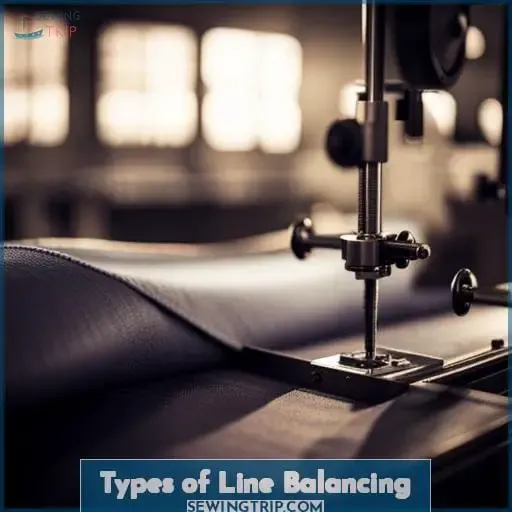This site is supported by our readers. We may earn a commission, at no cost to you, if you purchase through links.
 Looking to balance your sewing line? In this article, we’ll provide you with tips and techniques to achieve optimal efficiency. Whether you’re dealing with static or dynamic line balancing, we’ve got you covered.
Looking to balance your sewing line? In this article, we’ll provide you with tips and techniques to achieve optimal efficiency. Whether you’re dealing with static or dynamic line balancing, we’ve got you covered.
Learn how to:
- Automate or digitize the line balance in the garment industry
- Calculate sewing line efficiency
- Control work-in-progress (WIP)
- Improve overall productivity
Get ready to master the art of balancing a sewing line like a pro!
Table Of Contents
Key Takeaways
- Implement static and dynamic line balancing methods for improved flow and workload distribution.
- Embrace automation and digitization strategies to optimize production planning and control.
- Calculate sewing line efficiency using metrics such as cycle time, throughput rate, and utilization rate.
- Control work-in-progress inventory by monitoring levels, reducing excess, and ensuring line continuity.
Types of Line Balancing
Now let’s delve into the types of line balancing methods you can use to balance your sewing line effectively.
The two main types are static line balance and dynamic line balance. Each method offers its own advantages and considerations, so understanding these differences is crucial for optimizing your production process.
Static Line Balance
When balancing a sewing line, it’s important to understand the concept of static line balance, which involves assigning operations and tasks in a predetermined sequence.
To optimize workstation efficiency and maximize productivity, consider implementing these strategies:
- Workstation optimization for improved flow
- Utilization of skill matrix for operator allocation
- Understanding the impact of floaters on line performance
- Embracing continuous improvement practices
- Leveraging automation benefits for efficient production planning.
Dynamic Line Balance
To achieve optimal efficiency in garment production, dynamic line balancing is a crucial technique that involves the continuous adjustment of work assignments and resources to maintain an evenly distributed workload throughout the sewing line.
It requires careful management of operator skills through skill matrices, ensuring maximum operator efficiency.
Additionally, floaters play a significant role in addressing bottlenecks and maintaining smooth production flow.
Continuous improvement efforts are essential for refining and optimizing the algorithmic approach to dynamic line balancing while overcoming automation challenges.
How to Automate or Digitalize Line Balance in Garment Industry?
You can automate and digitalize line balancing in the garment industry by implementing advanced production management systems. This allows you to leverage automated solutions and digitalization tools to optimize line balance efficiently.
Here are three key ways to achieve automation and digitalization:
-
Software Integration:
Integrate various software applications that specialize in line balancing, such as those using artificial intelligence algorithms or manufacturing technology advancements like IoT applications.
-
Industry 4.0 Implementation:
Embrace the principles of Industry 4.0 by adopting smart factories and utilizing technologies like robotics, data analytics, cloud computing, and machine learning for seamless line balance control.
3.Implementing Automated Solutions:
Invest in automated machinery or equipment that can perform tasks traditionally done manually, reducing human error while improving efficiency on the sewing line.
By incorporating these strategies into your operations, you can enhance your overall productivity levels while achieving higher accuracy in maintaining a balanced sewing line.
How to Calculate Sewing Line Efficiency?
Calculating sewing line efficiency involves analyzing the performance and productivity of the production process to determine its effectiveness in achieving optimal output.
To measure sewing line efficiency, consider the following:
- Efficiency Metrics: Use key metrics such as cycle time, throughput rate, and utilization rate to evaluate overall performance.
- Performance Evaluation: Conduct regular work-time studies to assess operator productivity and identify areas for improvement.
- Process Optimization: Identify bottlenecks or inefficient operations that hinder productivity and implement strategies like rearranging workstations or reassigning operators to optimize workflow.
By evaluating these factors, you can gauge the efficiency of your sewing line and make informed decisions on how best to balance it for maximum output. Remember that continuous monitoring, analysis, and optimization are essential for maintaining high levels of efficiency in garment manufacturing.
How to Control WIP in Sewing Line?
To effectively control work-in-progress (WIP) in your sewing line, focus on implementing efficient inventory management strategies.
Here are three key techniques to control WIP in your sewing line:
- Monitoring Inventory:
Regularly track and monitor the levels of materials, components, and finished goods in stock. Use inventory management software or tools to maintain accurate records of what’s available at each stage of production.
- Reducing Work-in-Progress Optimization:
Analyze the bottlenecks within your sewing line that cause excessive WIP accumulation. Identify ways to streamline processes, eliminate unnecessary steps or tasks, and optimize machine utilization for improved efficiency.
3.Line Continuity Strategies:
Implement strategies such as floaters – multi-skilled operators who can fill gaps during absenteeism – to ensure continuity throughout the production process.
How to Improve Sewing Line Efficiency?
Looking to improve sewing line efficiency? Here are three strategies that can help you optimize your production process:
- Operator Training:
Provide comprehensive training programs for your operators to enhance their skills and knowledge. This will enable them to perform tasks more efficiently, reducing errors and increasing productivity.
- Workflow Analysis:
Conduct a thorough analysis of your workflow to identify any bottlenecks or areas of inefficiency. By streamlining the flow of work and eliminating unnecessary steps, you can improve overall line efficiency.
- Equipment Optimization:
Ensure that you have the right equipment in place for each operation on the sewing line. Regularly maintain and upgrade machinery as needed to minimize downtime and maximize productivity.
By implementing these strategies along with continuous monitoring of key performance indicators, such as cycle time and defect rate, you can make significant improvements in sewing line efficiency while maintaining quality standards.
Tips for Balancing a Sewing Line
Improve your sewing line efficiency with these practical tips for balancing a sewing line:
- Operator Efficiency: Implement a skill matrix to match operators with specific operations, ensuring optimal placement and utilization of their skills during line balancing.
- Floater Strategy: Utilize floaters, multi-skilled operators who can fill in for absentees or address bottlenecks in the production line, enhancing flexibility and resource utilization.
- Continuous Improvement: Embrace a culture of continuous improvement by incorporating methodologies like Goldratt’s The Goal and staying updated on advancements in production management systems.
These tips will help you streamline your sewing line, maximize productivity, and achieve better results. By focusing on operator efficiency, utilizing floaters strategically, and emphasizing continuous improvement practices,you can optimize your garment manufacturing processes.
Frequently Asked Questions (FAQs)
What are the common challenges faced in line balancing in the garment industry?
Common challenges in line balancing:
- Inefficiency
- Unstable performance
- Suboptimal transfers of semi-finished products.
Experience-based methods hinder optimization.
Need for a systematic approach to enhance productivity and stability in the garment industry.
How can the utilization of real-time production data aid in effective line balancing?
To effectively balance a sewing line, utilize real-time production data.
This aids in identifying bottlenecks and optimizing resource allocation.
With this information, you can make informed decisions to enhance productivity and achieve mastery over garment manufacturing processes.
What factors should be considered when managing operator skills in line balancing?
Consider operator skills when balancing a sewing line.
Utilize skill history data to identify proficient operators for specific tasks.
Accurate skill information ensures optimal placement and reshuffling during line balancing, enhancing productivity and efficiency.
How can the concept of floaters contribute to improving line continuity and flexibility?
Floaters, the superheroes of line balancing, contribute to seamless production flow.
They enhance line continuity by replacing absent operators and addressing bottlenecks.
With their flexibility and resource utilization, floaters empower you to achieve optimal line performance and mastery over garment production.
What are some recommended references and resources for line supervisors and industrial engineers seeking to enhance line balancing techniques?
Enhance your line balancing techniques with recommended references and resources.
Explore The Goal: A Process of Ongoing Improvement by E.M. Goldratt for insights on work leveling.
Continuously improve using reference books and evolving production management systems for optimal results.
Conclusion
To achieve optimal efficiency in balancing a sewing line, follow these tips and techniques:
- Whether you’re dealing with static or dynamic line balancing, automation and digitization can greatly improve the process.
- Calculate sewing line efficiency to track progress and make necessary adjustments.
- Control work-in-progress to avoid bottlenecks and delays.
- Finally, implement strategies to improve overall productivity.
With these techniques, you’ll be able to balance your sewing line like a pro and maximize your efficiency in the garment industry.












